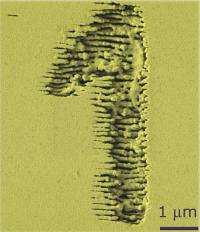New technique could benefit Alzheimer's diagnosis

Swinburne researchers have developed a technique to create a highly sensitive surface for measuring the concentration of a peptide that is a biomarker for early stage Alzheimer's disease.
Alzheimer's disease was first recorded more than 100 years ago, but there is still no effective therapy to stop or slow the progression of the disease. Sufferers can lose up to 60 per cent of their neuronal cells before a diagnosis is obtained.
Diagnosis at the very early stages before neuronal degeneration has begun is vital for testing and developing new treatments.
Abnormality of the beta amyloid peptide in cerebrospinal fluid appears to be the earliest and most significant marker of Alzheimer's. Currently there are no standardised tests to detect these biomarkers.
The researchers have developed a sensor based on nanotechnology that outperforms commercial sensors and demonstrates fast and reliable measurement of beta amyloid oligomers at low concentrations.
The key to the high sensitivity is the laser nano-textured gold coated surface. This sensor can identify concentrations of beta amyloid in a quantitative manner for the first time.
"We showed that sensors based on light scattering can indeed deliver QUANTATIVE measurements and they can be made fast," Professor of Nanophotonics Saulius Juodkazis said.
"The sensor platform we developed by laser nano-texturing of surfaces is delivering results of the highest sensitivity and repeatability.
"The challenge is to create fast and efficient fabrication of sensors based on nanotechnology and develop new analytical methods of detection. This means we should be able to detect markers of diseases at far lower levels."
Surface enhanced Raman spectroscopy (SERS) is one of the most sensitive and highly specific label-free detection methods which may evolve as a detection technique for different forms of beta amyloid or as a rapid, low cost technique to validate new biomarkers before developing standard assays for enzyme-linked immunosorbent assays (ELISAs).
This research is a PhD project work of Dr Ricardas Buividas who received his doctorate in May 2014. It was published in the Journal of Biophotonics.
More information: Buividas, R., Dzingelevičius, N., Kubiliūtė, R., Stoddart, P. R., Khanh Truong, V., Ivanova, E. P. and Juodkazis, S. (2014), "Statistically quantified measurement of an Alzheimer's marker by surface-enhanced Raman scattering." J. Biophoton.. doi: 10.1002/jbio.201400017


















